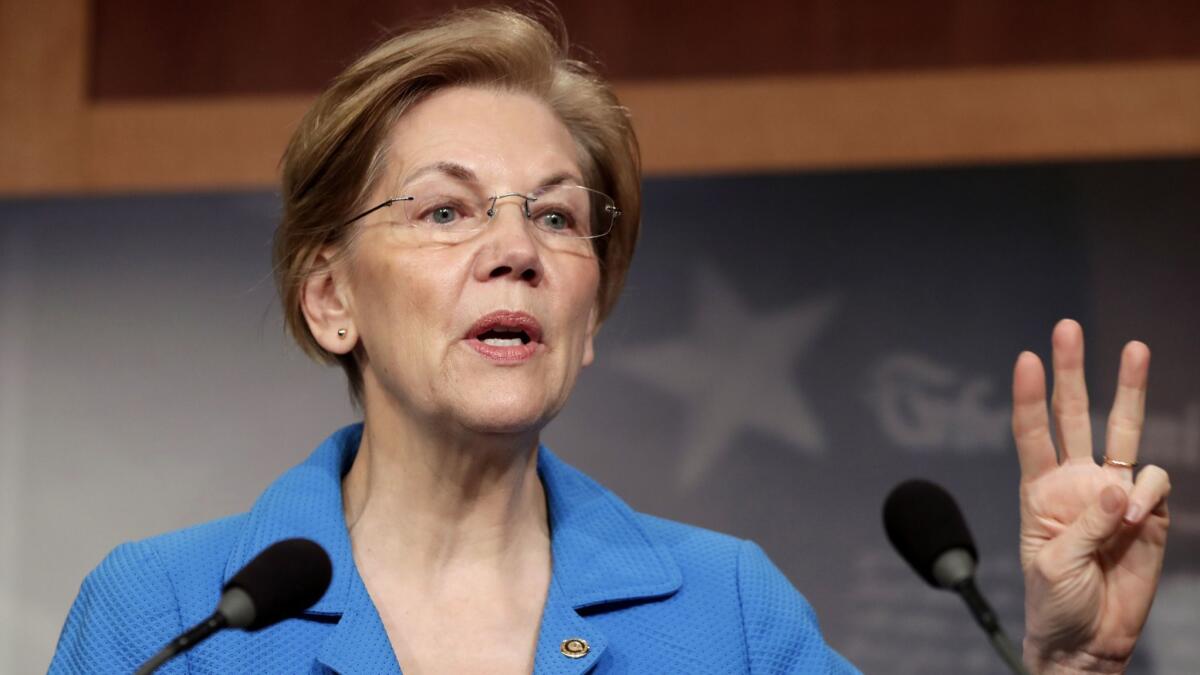Wells Fargo will need a formal vote from the Federal Reserve before growth restrictions are lifted

- Share via
Reporting from Washington — Wells Fargo & Co. will have to receive formal approval in a vote taken by the Federal Reserve Board of Governors before its growth restriction is lifted, Fed Chairman Jerome H. Powell has decided — a move that could cut into the bank’s profits.
Powell disclosed his determination in a letter Thursday to Sen. Elizabeth Warren (D-Mass.), who had pushed for a board vote — rather than just a staff endorsement — so Congress and the public could hold the Fed accountable when it decides whether to lift the stiff penalty stemming from the San Francisco bank’s unauthorized-accounts scandal and other consumer abuses.
Wells Fargo Chief Executive Timothy Sloan separately told investors Thursday at a conference that he expected the restriction, which stopped the bank from growing its assets beyond the $1.95 trillion reached at the end of last year, would probably continue into 2019.
Warren pressed Powell to hold a formal vote on lifting the cap when he testified at a Senate Banking Committee hearing in March. She followed up with a letter last month.
“I’m glad the Fed’s Board of Governors changed course and will vote on whether to lift the growth restriction, rather than delegating that important question,” Warren said in response to Powell’s decision. “The Fed must strictly enforce its order to show Wells Fargo that it means business.”
President Trump last month nominated economist Richard Clarida and state banking regulator Michelle Bowman to fill vacant seats on the seven-member Fed board. There are likely to be questions on how they would handle lifting the Wells Fargo growth restriction during their confirmation hearing before the Senate Banking Committee on Tuesday.
A Wells Fargo spokeswoman declined to comment Friday.
Jaret Seiberg, an analyst with brokerage and investment bank Cowen & Co., said in a research note that Powell’s decision to hold a formal vote means the growth restriction “could easily remain in place into the second half of 2019” and longer if more problems arise at the bank.
“Rescinding the asset cap was always going to be politically difficult given the distrust on the far left and the far right when it comes to the mega banks,” Seiberg said. “Powell’s move only further ratchets up the politics.”
Ken Leon, an equity analyst at research firm CFRA, said Thursday that the longer the cap is in place, the harder it will be for the bank to manage its affairs without hampering key parts of its business. Making loans is the core business for the bank, and loans are considered assets because they generate income.
Still, Wells Fargo Treasurer Neal Blinde said Thursday at Wells Fargo’s investor day in Charlotte, N.C., that the Fed growth cap is only expected to cut $100 million into this year’s profit, instead of an earlier estimate of $400 million.
The initial estimate was made before the bank experienced a new round of bad headlines, in particular a $1-billion penalty handed down by federal regulators last month over the same consumer abuses underlying the Fed’s enforcement action.
Those headlines may have slowed the bank’s loan and deposit growth, Leon said — mitigating the impact of the asset cap.
In February, the Fed board voted unanimously to order Wells Fargo to cap its growth and improve its corporate governance in response to its consumer abuses.
The consent order required Wells Fargo’s board of directors to submit written plans to improve its oversight and risk management, which they did last month. An independent review by a third-party firm must be completed by Sept. 30 to determine how Wells Fargo is implementing the plans.
“Given the breadth of the wrongdoing at Wells Fargo and the enormous number of consumers affected, the Fed’s governors — not its staff — should be responsible for determining whether Wells Fargo is complying with the consent order,” Warren wrote in her April 3 letter.
At the March hearing, Powell said the growth restriction would not be easily lifted but the decision to do so would be made by the staff “in serious consultation” with Fed board members.
Warren complained that decisions on enforcement actions should be made in formal votes by Fed board members, who hold Senate-confirmed positions.
“After further consideration, the decision about terminating the asset growth restriction will be made by a vote of the Board of Governors,” Powell wrote to Warren. “As the terms of the order make clear, the firm must make significant progress in remedying its oversight and compliance and operational risk management deficiencies before relief from the asset growth restriction would be forthcoming,”
Sloan told investors on Thursday that the Fed has responded with feedback on the bank’s compliance plans.
“To have enough time to incorporate that feedback, we’re making plans to operate under the asset cap through the first part of 2019,” Sloan said.
Warren also asked Powell to publicly release the findings of the independent review of Wells Fargo’s remediation plan implementation.
Powell responded in his Thursday letter that such reviews typically contain mostly confidential information. But he said the Fed would look at the review to determine “whether and to what extent the report can be publicly disclosed.”
In 2016, Wells Fargo agreed to pay $185 million to settle investigations by other regulators into the bank’s creation of millions of accounts for customers without their authorization. The practice, traced to aggressive sales goals, was first reported by the Los Angeles Times in 2013.
But the problems have continued for Wells Fargo.
Last month, the bank was hit with its $1-billion fine from the Office of the Comptroller of the Currency and the Consumer Financial Protection Bureau over the same consumer abuses underlying the Fed’s enforcement action.
And last week, Wells Fargo reached a $480-million settlement with shareholders who said they were shortchanged when the bank’s stock plunged after the accounts scandal mushroomed in September 2016.
Twitter: @JimPuzzanghera
Staff writer James Rufus Koren contributed to this report.
UPDATES:
11:55 a.m.: This article was updated with comment from Jaret Seiberg of Cowen & Co. and additional background.
This article originally was published at 2 a.m.
More to Read
Inside the business of entertainment
The Wide Shot brings you news, analysis and insights on everything from streaming wars to production — and what it all means for the future.
You may occasionally receive promotional content from the Los Angeles Times.











